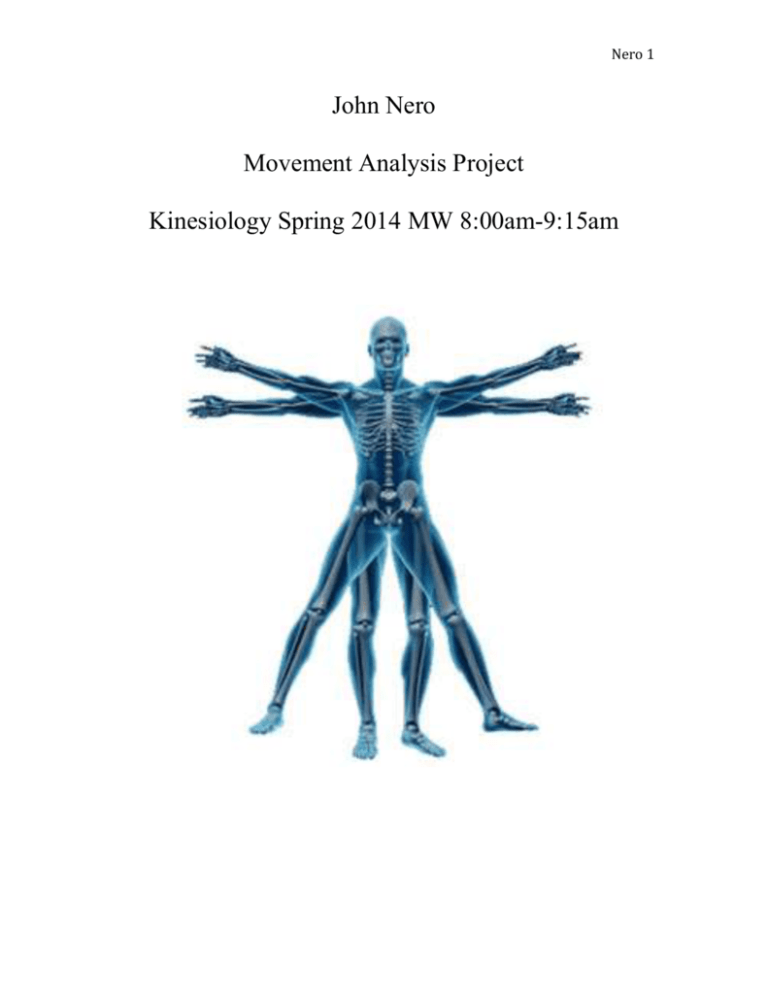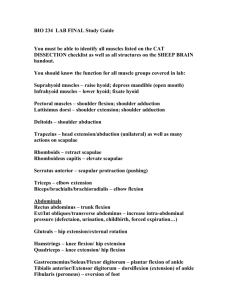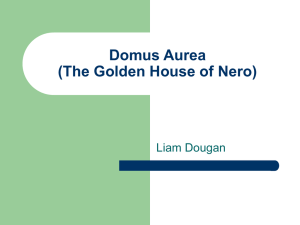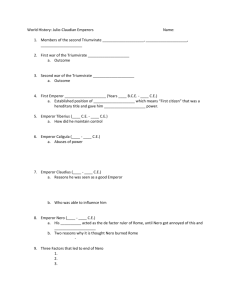Movement Analysis
advertisement

Nero 1 John Nero Movement Analysis Project Kinesiology Spring 2014 MW 8:00am-9:15am Nero 2 Individual Information Name: John Nero Birthdate: 12/17/1992 Age: 21 Gender: M Height: 73 in | 185.42 cm Weight: 165 lbs. | 74.84 kg BMI: 21.8 Blood Pressure: 122/81 Physical History List any medical conditions or diseases that limit or affect bodily movement: None List current or previous injuries that affect movement: I fractured my left pinkie metatarsal bone in 2006 I also tore ligaments in my left ankle in 2010 I had my right testicle removed in 2013 List activities that you have or do participate in that require more than an average amount of movement (ex. Sports, exercise, etc.) Have done: Basketball (10 years) Football (6 years) Track Throwing (3 years) Baseball (1 year) Nero 3 Soccer (1 year) Now: Weight Lifting (4-5x a week) Basketball (1x a week) Run 3 miles a week Please describe your occupation and the activities involved: My occupation is a part time server at Scotland Run Golf Club. I usually work 23x a week. The job requires moderate physical activity. The job requires me to utilize my balance and strength. For example, lifting a food tray to bring to a table and balancing a tray with several drinks. Also, I am constantly on my feet walking around. Please list past surgeries: Orchiectomy (testicle removal) 2013 Do you suffer from joint or muscle related pain? Please describe: None Goals Please list personal movement goals: 1. To improve the flexibility of toe touching. 2. Repair the range of motion in my lower abdominals, due to past surgery. 3. Improve range of motion in my hips. Initial Summary As I was growing up as an obese child, there were several limitations to my movements. I eventually started to participate in organized physical activity (sports) Nero 4 when I was about 10 years old. The amount of time I dedicated to sports was significant; therefor, my movement limitations began to decrease. Today, I spend much of my time to physical fitness and strive to be healthy. I have developed efficient body movements, which enables me to lift weights without damaging myself. Having said that however, my overall flexibility is poor. For example, I cannot bend over and touch my toes or sit down and reach my toes. This is an area in which I need to improve on. Also, I had surgery in 2013 that involved the removal of my right testicle. The incision was executed where my lower abdominals are located. This type of injury prevents me from high intensity abdominal exercise. I want to restore my abdominal strength to where in was. I have strengths throughout my body movements; however, I also have weaknesses. I will work to progress in both areas over the course of the semester. Rang of Motion Analysis The table below represents the range of motion of various joints in my body. Motion Cervical Region Flexion Extension Rotation Lateral Flexion Glenohumeral Region Abduction Flexion Internal Rotation External Rotation Degree of Motion Normal ROM? Right Left Right Left 65 73 81 40 65 73 81 40 Yes Yes Yes Yes Yes Yes Yes Yes 175 161 73 174 159 73 Yes No Yes Yes No Yes 90 90 Yes Yes Nero 5 Knee Region Extension Flexion Hip Region Flexion External Rotation Internal Rotation Abduction 0 150 0 150 Yes Yes Yes Yes 99 53 98 53 No No No No 34 33 50 50 Yes No Yes Yes No Yes Elbow Region Flexion Extension 146 0 146 0 Yes Yes Yes Yes Radioulnar Region Pronation Supination 79 90 79 90 Yes Yes Yes Yes 70 61 31 70 59 30 Yes Yes Yes Yes Yes Yes 20 18 Yes Yes Wrist Region Flexion Extension Ulnar Deviation Radial Deviation Nero 6 Neutral Position Flexion (cervical) Extension (cervical) Lateral Flexion (cervical) Rotation (cervical) Neutral Position Abduction (shoulder) Flexion (shoulder) Internal Rotation (shoulder) External Rotation (shoulder) Flexion (elbow) Extension (elbow) Nero 7 Supination (radioulnar) Radial Deviation (wrist) Internal Rotation (hip) Pronation (radioulnar) Ulnar Deviation (wrist) External Rotation (hip) Flexion (wrist) Extension (wrist) Flexion (hip) Abduction (hip) Flexion (knee) Extension (knee) After the conclusion of my range of motion analysis, my overall ROM is average with the exception of a few joints. Throughout my analysis, I have discovered my right side joints/limbs have a greater degree then opposed to my left side. For example, my extension, radial deviation, and ulnar deviation in my right wrist region, all slightly had a greater degree. I believe this is because my right side joints/limbs are my dominant usage. Nero 8 My theory states the more an individual utilizes his or her dominant hand, the better range of motion will be. My overall range of motion throughout this analysis appeared to be normal. Having said that, however, there were a few results that were intriguing. One, being that my shoulder flexion was abnormal. I have never received any sort of injury to that specific region, but it is a region where I tend to build muscle. I believe from not consistently stretching the muscle enough, resulted in low ROM. Acquiring the knowledge of my range of motion can have beneficial effects for the future profession that I will be pursuing. The analysis’s results allow me to realize which specific joints I need to improve on. This is important to maintain a healthy lifestyle and prevent significant injuries. I will assess myself and also apply my knowledge to patients who need improvements in specific articulations. Postural Needs Assessment Subject’s Name: John Nero Assessor’s Name: Dr. Franlinger Date: March 30th 2014 Frontal View Eyes Aligned Yes No If no, which side higher Right Left AC Joint Aligned Left Yes No If no, which side higher Right ASIS Aligned Left Yes No If no, which side higher Right Patella Height Even Left Yes No If no, which side higher Right Patella Faces Forward In Yes No If no, facing which way Out Genu Valgum Both Yes No If yes, which side R L Nero 9 Genu Varum Both Yes No If yes, which side R L Feet Face Forward Both Facing which way Yes No If no, which one R L Out In If yes, which side R L Head Protruded Sagittal View Yes No Protracted Shoulder Girdle Yes No Kyphosis Yes No Excessive Lordosis Yes No Reduced Lordosis Yes No Genu Recurvatum Both Yes No *SLIGHTLY Winged Scapula Both Yes Posterior View No If yes, which side Feet Evert Both Yes No If yes, which foot R L Feet Invert Both Yes No If yes, which foot R L R L Nero 10 Anterior View Sagittal View Posterior View Overall, my postural alignment is normal; however, there are a couple issues that can be identified with close examination. Starting from the inferior portion of my body, my feet face forward, but are turned slightly outward. Possible causes for this postural misalignment are overactive muscles that include: lateral gastrocnemius, soleus, piriformis, or biceps femoris and underactive muscles, which include: medial gastrocnemius and medial hamstrings. This relates directly to my flexibility in which I cannot touch my toes, when attempting the toe touch stretch. One of my personal goals is to become more flexible. The postural assessment identified the issues that prevent me from fully stretching my hamstrings. Also, the study has shown me which muscles are underactive. I’m now aware of the specific muscles in which I need to improve upon. I have always thought my feet were slightly turned outward because of past injuries. I torn ligaments in my left ankle and broken bones in my right foot; however, the postural assessment showed different factors that caused my feet to slightly turn outward. Nero 11 Lastly, the superior portion of my body, my head (cervical region) is slightly protruded. Having said that; however, my spine shows no visual of lordosis or kyphosis. I never had any type of injury to my cervical region of the spine. The only factor that could possibly contribute to my head slightly protruding would be my years of participating in football. My helmet and impacts to the head are the only possible factors that can be considered. After the conclusion of the postural assessment, accurate causes for this misalignment could be overactive muscles such as SCM, and underactive muscles such as cervical extensors and stabilizers. I want to improve the stability and flexibility in the cervical region of the spine; therefore, preventing any severe injuries. The postural analysis will help me complete my goal, which is improving my overall flexibility. Overhead Squat Analysis Subject’s Name: John Nero Assessor’s Name: Dr. Franlinger Date: March 30th 2014 Anterior View Knees Align with foot: Yes No If no, which one R L Both which way valgus varus Feet Face Forward: Yes No If no, which one R L Both which way abduct adduct Normal Forward Flexion: Yes Sagittal View No, excessive forward lean Normal Lumbar Lordosis: Yes lordosis If no, Arms Remain in Line: No, Yes excessive lordosis or reduced *ARMS SLIGHTLY EXTENDED Feet Evert: Yes Posterior View No Heels Rise Off Floor: Yes No Nero 12 Asymmetrical Shift: Yes No If yes which side R L Anterior View My shoulders and knees are aligned straight. My knees are facing forward and have no valgus or varus misalignment. My feet are straight, showing neither abduct nor adduct. Anterior view of my overhead squat is correct and normal. Having the correct form of squat will activate underactive muscles such as the glutes. This will help my flexibility, which will also improve my ROM. Sagittal/Lateral View Although my scores had normal measurements in all sections of the sagittal/lateral view, my shoulders/arms were slightly extended off the parallel alignment. Possible causes for the postural misalignment include: overacting my major and minor pectoralis and underacting my rhomboids and middle trapezius. This is not a significant problem now; however, possibly could be one in the future. I can improve this misalignment activating my rhomboids Nero 13 and middle trapezius through exercise. There are no symptoms of lumbar lordosis and I have normal forward flexion. Besides my arms are slightly extending, the sagittal view of my overhead squat is correct. Posterior View All scores had normal measurements in the posterior view. Again, there were no symptoms of either valgus or varus direction. My knees and shoulders were aligned correctly and my feet were straight. There are no appearances of asymmetrical shifts or heels rising off the floor. Overall, my overhead squat form is perfect, with the exception of my shoulders slightly extending. Nero 14 Gait Analysis Stance Phase *Heel Strike* My initial contact with the treadmill reveals my right heel supinating and externally rotating my right leg. It appears that I excessively tend to walk on the outside of my foot, which can cause injuries. Stance Phase *Mid-Stance* My right foot I completely flat throughout the entire phase. Following the supination of my right heel, my right foot stays in supination and continues to externally rotate my right leg. My vertical alignment appears to be abnormal. My knee and ankle are aligned; however, my hip is not. Nero 15 Stand Phase *Heel Off* As my right heel begins to lift off, it starts to slowly supinate. Also, slightly supinating my calcaneus and talus. Stance Phase *Toe Off* Following heel off, my right ankle is in full supination pushes off the treadmill. The right like begins to externally rotate. Swing Phase *Initial Swing* My right leg begins to move forward by the pull of my right hip flexors. The left foot is in mid-stance, while the right leg is moving forward. Nero 16 Swing Phase *Mid-Swing* The right leg moves forward and straightens. My left leg begins to externally rotates and the left ankle begins to supinate. Swing Phase *Terminal Swing* In the final stage of the gait cycle, my right hip flex’s, right knee slightly extends, and my right ankle is in dorsiflexion. The process of my right ankle supinating and my right leg externally rotating begins again. Nero 17 Corrective Exercise Program for Upper and Lower Body The conclusions of the overhead squat, postural analysis, gait, and range of motion; has revealed specific dysfunctions that are limiting my lower body flexibility and my ability to strengthen my lower core. These complications can be corrected through corrective exercises and adjustments. The following shows areas in which I need to improve upon: 1. Protracted shoulder Girdle: 2. Feet Invert/Supinate 3. Lower Back Arch Corrective Exercises for Protracted Shoulder Girdle: This picture displays my protracted shoulder girdle (rounded shoulders). The major and minor pectoralis muscles are overactive in a protracted shoulder girdle. This makes perfect sense because I tend to exercise my major and minor pectoralis muscles excessively. My rhomboids and middle trapezius are underactive muscles, which are key factors in a protracted shoulder girdle. I can fix my protracted shoulder girdle postural dysfunction through corrective exercises and stretches. Nero 18 First, I would start by stretching my overactive muscles (major and minor pectoralis) by placing my forearm and hand on a plastic ball or steady object, and begin to slightly lean forward. This lengthens and relaxes my chest muscles. Also, loosens and prepares the muscles for an exercise. Hold the stretch for 20-30 seconds. Following the stretch, I will strengthen my underactive muscles (rhomboids and middle trapezius) through a seated row exercise. The seated row performs a retracting motion. The rhomboids and middle trapezius are agonist in a retraction movement; therefore, this exercise is an effective exercise. Corrective Exercises for Foot Inversion/Supination The gait analysis has showed me that my feet/ankles tend to invert/supinate often. This can cause painful injuries, such as torn ligaments and sprained ankles. Possible overactive muscles include: lateral gastrocnemius, soleus, piriformis, or biceps femoris. My underactive muscles include: medial gastrocnemius, and medial hamstrings. Nero 19 Straitening and pulling the leg forward, while lying on your back, can stretch the medial gastrocnemius and hamstring. While pulling the leg forward, (stretching the medial hamstring) plantar flex the foot towards you to stretch the medial gastrocnemius. This will strengthen the underactive muscles (medial gastrocnemius & hamstring). Following the stretching, this picture displays how to exercise the medial hamstring. Have the primary foot start on top of a chair. Adduct the leg to the ground, slightly rotating the knee. The medial hamstring is the agonist in this exercise. Following the stretching, this picture displays for to exercise the medial gastrocnemius. Place the primary leg/foot on the stepping block. Slightly externally rotate your lower, so that you toes are pointing outward. Begin to lift your heel up and down. The medial gastrocnemius are the agonist in this exercise. Nero 20 Corrective Exercises for Lower Back Arch: In my overhead squat analysis examination, I appear to have a slight arch in my lower back. Overactive muscles contributed to this dysfunction include: Superficial erector spinae and hip flexors. Underactive muscles include: Anterior core and hamstrings. I will start by stretching my anterior abdominals. First, lay on the ground in prone. Next, push your upper body up, while at the same time keeping you hips/lower body flat to the ground. Hold the stretch for 20-30 seconds. For stretching the hamstrings, flex the hip 90 degrees and then slightly extend the knee making sure the contralateral leg stays flat on the floor with the knee in slight Nero 21 extension. Hold the stretch for 20-30 seconds and alternate legs. There are several ways to exercise the anterior abdominal muscles. Simple crunches will activate anterior abdominals muscles, especially the rectus abdominal. First lay flat on the ground with your knees flexed. While keeping your feet on the ground and knees flexed, slowly lift your upper body up to where your hands meet your knees, then slowly come back down. Following the hamstring stretches, an exercise for the hamstring will be performed. While laying on the ground, place your feet and lower gastrocnemius on a medium plastic ball. Keep your body straight. Flex your knees, while keeping your lower feet and gastrocnemius on the ball. Repeat this process. Conclusion of the Movement Analysis Overall, the assessment of myself was extremely informative and helpful. I’ve discovered postural dysfunctions, of which I wasn’t aware before. I learned specific corrective exercises to enhance my physicality. I will apply the knowledge that I have Nero 22 learned from this assessment and apply it to my daily life in order to live a heally steady lifestyle.




